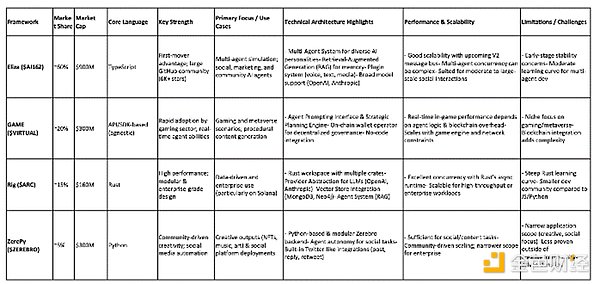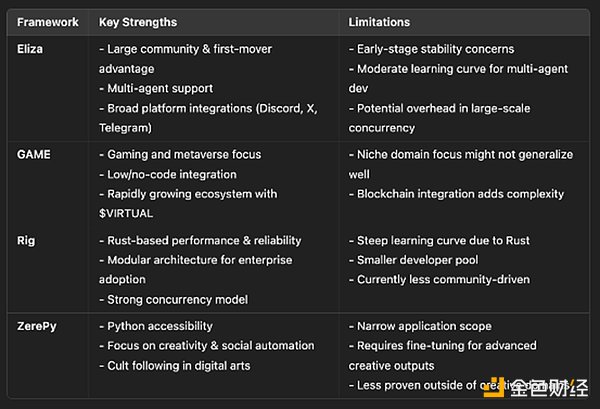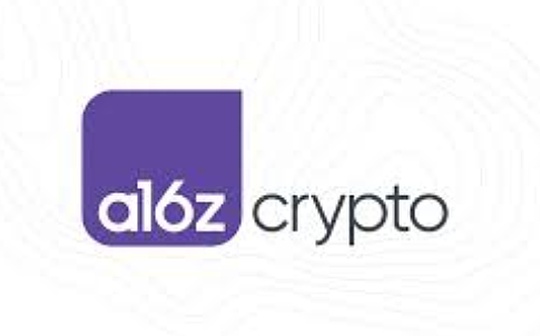Crypto x AI framework comparison: Eliza, GAME, Rig, ZerePy

Reprinted from jinse
01/02/2025·4MAuthor: Arndxt, Threading on the Edge; Translation: Golden Finance xiaozou
There are four main frameworks in the Crypto x AI field: Eliza (AI16Z), GAME (VIRTUAL), Rig (ARC) and ZerePy (ZEREBRO).

Each of these four frameworks can meet different development needs.
Eliza dominates with ~60% market share, driven by first-mover advantage and a thriving TypeScript community, while GAME (~20% market share) targets fast- adopting gaming and virtual world applications.
Rig (approximately 15% market share) is developed using Rust and provides performance-oriented modularity suitable for the Solana ecosystem, while ZerePy (approximately 5% market share), a new Python-based architecture, focuses on creative output and Social media automation. The combined market capitalization of these frameworks is $1.7 billion, and as AI crypto applications expand, the total market capitalization of these frameworks could reach more than $20 billion, making the market-cap-weighted approach potentially attractive. Each framework occupies its own unique niche—social and multi-agent agents (Eliza), games/virtual worlds (GAME), enterprise performance (Rig), and creative community use (ZerePy)—offering complementary options to each other. Not direct competition.
1. Overview of the four major frameworks and market positioning

( 1 ) Eliza ($AI16Z)
● Market share: ~60%
● Market value: US$900 million
● Core language: TypeScript
●Main advantages: First-mover advantage, extensive GitHub community (more than 6,000 stars, 1,800 forks)
● Focus: multi-agent simulation, cross-platform social participation
As one of the earliest AI agent frameworks in the field, Eliza dominates the scene. Its first-mover advantage is supported by a large community of contributors, which accelerates development and promotes user adoption. Eliza's TypeScript stack makes it ideal for developers working in web-based ecosystems, ensuring broad appeal.
( 2 ) GAME (VIRTUAL)
● Market share: ~20%
● Market value: US$300 million
● Core language: (based on API/SDK; using language-independent approach)
● Key advantages: Rapid adoption in the gaming industry, real-time proxy functionality.
● Focus: program content generation, adaptive NPC behavior.
GAME is tailor-made for gaming and virtual world applications. Its API-driven architecture and close connection to the VIRTUAL ecosystem have inspired huge momentum: more than 200 projects have been harvested, 150,000 requests per day, and rapid weekly growth. GAME's no-code integration further appeals to teams that prioritize rapid deployment over deep technical customization.
( 3 ) Rig (ARC)
● Market share: ~15%
● Market capitalization: US$160 million
● Core language: Rust
● Main advantages: performance, modular design (enterprise level)
● Focus: Solana-based "pure-play pure game", emphasizing retrieval enhancement generation.
Rig is based on the Rust architecture and caters to developers who value speed, memory safety, and efficient concurrency. It is designed for "enterprise-grade" or heavily data-driven applications, especially those on Solana. Despite the steep learning curve, Rig offers modular performance and reliability that can appeal to system-oriented developers.
( 4 ) ZerePy (ZEREBRO)
● Market share: ~5%
● Market value: US$300 million
● Core language: Python
● Key Benefits: Community-driven creativity, social media automation.
● Focus: Agent deployment on social platforms, especially for artistic or niche output.
ZerePy is a latecomer, derived from Zerebro's core backend. Its Python foundation, coupled with its focus on creative applications (NFTs, music, and digital art), has attracted a cult following. The collaboration with Eliza has increased ZerePy's visibility, but ZerePy's narrow focus may limit adoption by a wide range of enterprises.
2. Technical architecture and core components
( 1 ) Eliza (AI16Z)
● Multi-agent system: deploy multiple AI personalities under a shared runtime.
● Memory Management (RAG): Implements a retrieval-enhanced generation pipeline for long-term context.
● Plug-in system: Supports community-developed extensions for voice, text, and media parsing (for example: PDF, images, etc.).
● Extensive model support: Integrate local open source LLM or cloud API (OpenAI, Anthropic).
Eliza's technical design is centered around multimodal communication, making it ideal for social, marketing, or community-based AI agents. While it excels at easy integration (Discord, X, Telegram), large-scale use also requires careful orchestration of different agent personalities and memory modules.
( 2 ) GAME (VIRTUAL)
● API + SDK model: Simplify agency integration for game companies and virtual world projects.
● Agent Prompt Interface: Coordinates the interaction between user input and the agent strategy engine.
● Strategic planning engine: Splits agent logic into high-level goal planning and low-level strategy execution.
● Blockchain integration: potential on-chain wallet operators for decentralized proxy governance.
GAME's architecture is highly customized for gaming or virtual environments, prioritizing real-time performance and continuous agent adaptation. While its role is not limited to gaming, the system is clearly designed for virtual worlds and procedurally generated scenarios.
( 3 ) Rig (ARC)
● Rust Workspace Structure: To ensure clarity and modularity, functionality is separated into multiple crates.
● Provider Abstraction Layer: Standardizes interaction with various LLM providers (OpenAI, Anthropic).
● Vector Store Integration: Supports multiple backends (MongoDB, Neo4j) for context retrieval.
● Agent System: embedded retrieval enhancement generation (RAG) and use of special tools.
Rig's high-performance design benefits from Rust's concurrency model, making it ideal for enterprise environments that require strict resource management. Its conceptual clarity—through layered abstractions—provides strong reliability, but Rust’s learning curve may limit the number of developers.
( 4 ) ZerePy (ZEREBRO)
● Python-based development: accessible to AI/ML developers who are familiar with Python code bases and workflows.
● Modular Zerebro backend: Provides creative content generation, especially for social media and art.
● Agent autonomy: Focus on “creative output” such as memes, music, and NFT generation tasks.
● Social platform integration: includes built-in commands (post, reply, forward) similar to Twitter functions.
ZerePy fills a gap for Python developers looking to deploy agents directly on social platforms. While ZerePy has a narrower scope than Eliza or Rig, its art- or entertainment-driven use cases thrive, especially in the decentralized community.
3. Comparative dimensions of the four major frameworks
( 1 ) Availability
● Eliza: Takes a balanced approach, posing a moderate learning curve due to the complexity of multi-agent, but with a strong TypeScript developer base.
● GAME: Designed for non-technical adopters in the gaming space, offering a no-code or low-code approach.
● Rig: more challenging; the Rust language strictly requires professional knowledge, but can gain high performance and reliability.
● ZerePy: Easiest for Python users, especially in creative or media-focused AI tasks.
( 2 ) Scalability
● Eliza: The V2 iteration introduced a scalable message bus, improving concurrency, but multi-broker concurrency can be complex.
● GAME: Scalability is related to real-time game requirements and blockchain networks; if game engine constraints are controlled, performance will remain unchanged.
● Rig: Naturally scalable via Rust’s asynchronous runtime, suitable for high- throughput or enterprise-level workloads.
● ZerePy: Extensions are community driven and primarily tested in creative or social media environments with less emphasis on large enterprise loads.
( 3 ) Adaptability
● Eliza: The most adaptable to plug-in systems, with extensive model support and cross-platform integration.
● GAME: Specifically adapted to the game environment and can be integrated into various game engines, but it is not very suitable for other fields outside the game field.
● Rig: Suitable for data-intensive tasks or enterprise tasks; provides flexible vendor levels for multi-LLM and vector storage.
● ZerePy: For creative output; easy to expand in the Python ecosystem, but the scope of the field is relatively narrow.
( 4 ) Performance
● Eliza: Optimized for fast-changing social media or conversational tasks, whose performance depends on external model APIs.
● GAME: A real-time representation of game dynamics; its success depends on the interplay of agent logic and blockchain overhead.
● Rig: Due to Rust’s concurrency and memory safety, it has high performance and is very suitable for complex large-scale AI processes.
● ZerePy: Performance depends on Python's speed and model calls; generally sufficient for social/content tasks, but not targeted for enterprise-grade throughput.
4. Advantages and limitations

5. Market potential and prospects
All four frameworks have a combined market capitalization of US$1.7 billion, with the potential to grow to over US$20 billion if the AI x Crypto industry follows the explosive growth pattern once seen in L1 blockchains. For investors who believe these frameworks, each serving a different market niche, will rise together within a broader "up" trend, a cap-weighted approach may be most prudent.
● Eliza (AI16Z): It may continue to hold the highest market share due to its established ecosystem, strong code base and upcoming enhanced version V2 (e.g. Coinbase proxy suite integration, TEE support).
● GAME (VIRTUAL): It is expected to be further popularized in games/virtual worlds. Synergies with the VIRTUAL ecosystem ensure continued developer interest.
● Rig (ARC): Could become a “hidden gem” for enterprise AI on Solana; as its partnership program matures, it could replicate the traction that other chain- specific frameworks have.
● ZerePy (ZEREBRO): Although its scope is small, it benefits from strong community momentum and the Python ecosystem, specifically targeting creative and artistic use cases that are often overlooked by more general solutions.
6. Comparison and summary
( 1 ) Technology stack and learning curve
● Eliza (TypeScript) strikes a balance between accessibility and rich functionality.
● GAME provides an accessible API for games, but may be targeted at niche groups.
● Rig (Rust) maximizes performance at the expense of a higher complexity threshold.
● ZerePy (Python) is simple for creative applications but lacks wider enterprise adoption.
( 2 ) Community and ecosystem
● Eliza: Top performer on GitHub, reflecting strong community participation and broad applicability.
● GAME: Thanks to the support of VIRTUAL, it has achieved rapid growth in the field of games and virtual worlds.
● Rig: Targeted at a small community of technically savvy developers, focused on high-performance use cases.
● ZerePy: A growing niche community built around creative and decentralized art, whose development benefits from a partnership with Eliza.
( 3 ) Catalysts for future growth
● Eliza: The new plugin registry and TEE integration may further solidify its leadership position.
● GAME: Actively expanding through VIRTUAL’s ecosystem; accessible to non- technical users.
● Rig: Once developer traction increases, cooperation with Solana may be reached, and the focus on enterprises may lead to strong growth.
● ZerePy: Leverage Python’s popularity in the AI field and cultural momentum around creative, community-driven projects.




 panewslab
panewslab